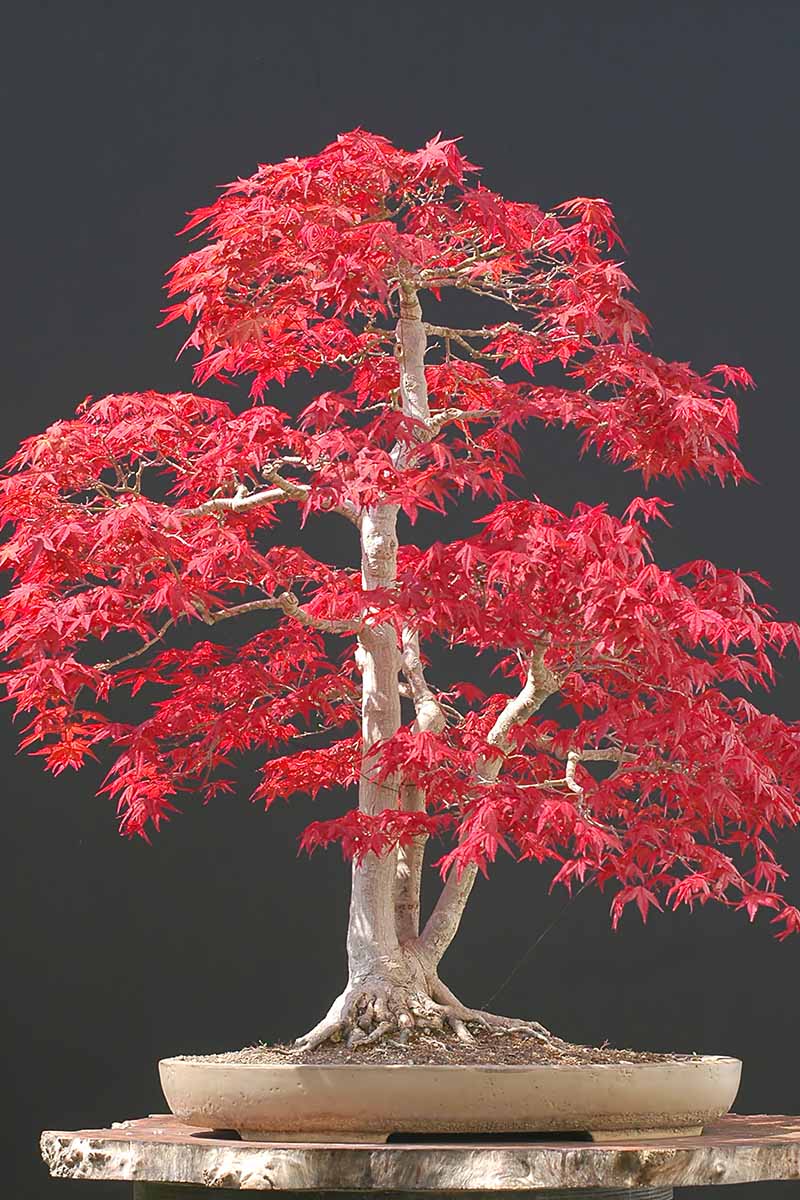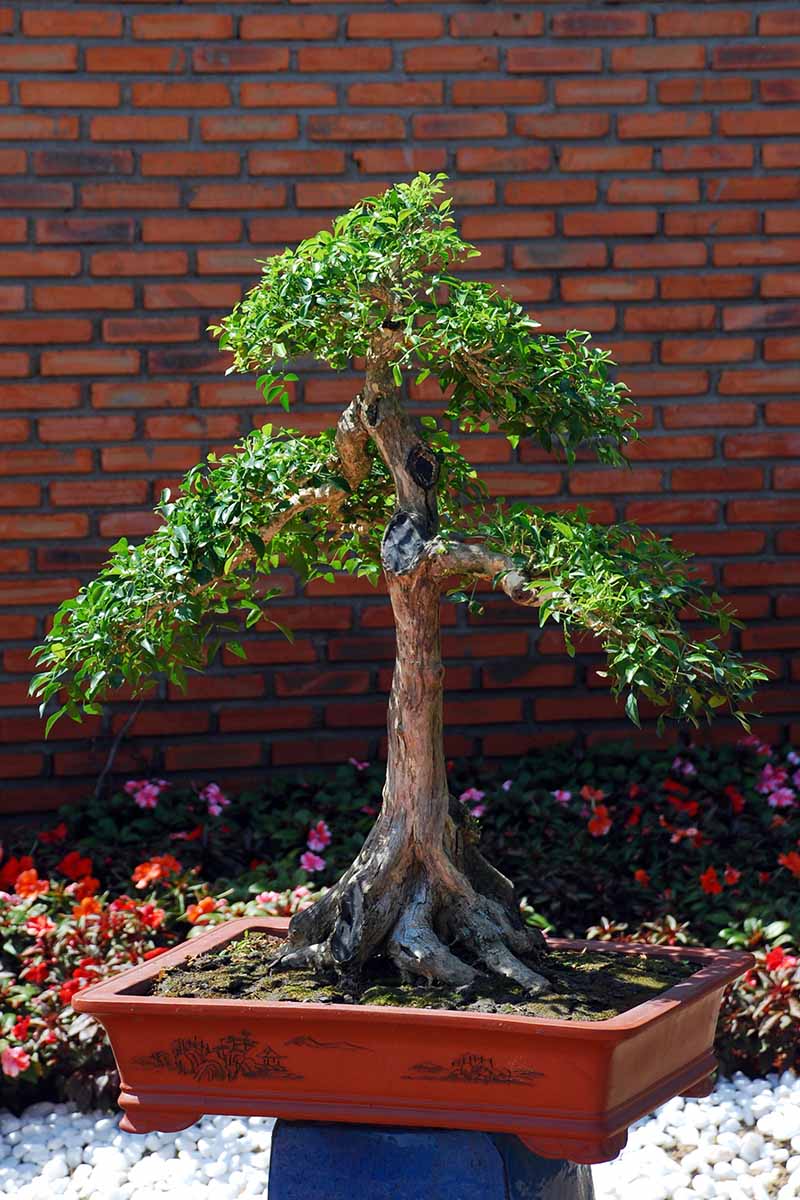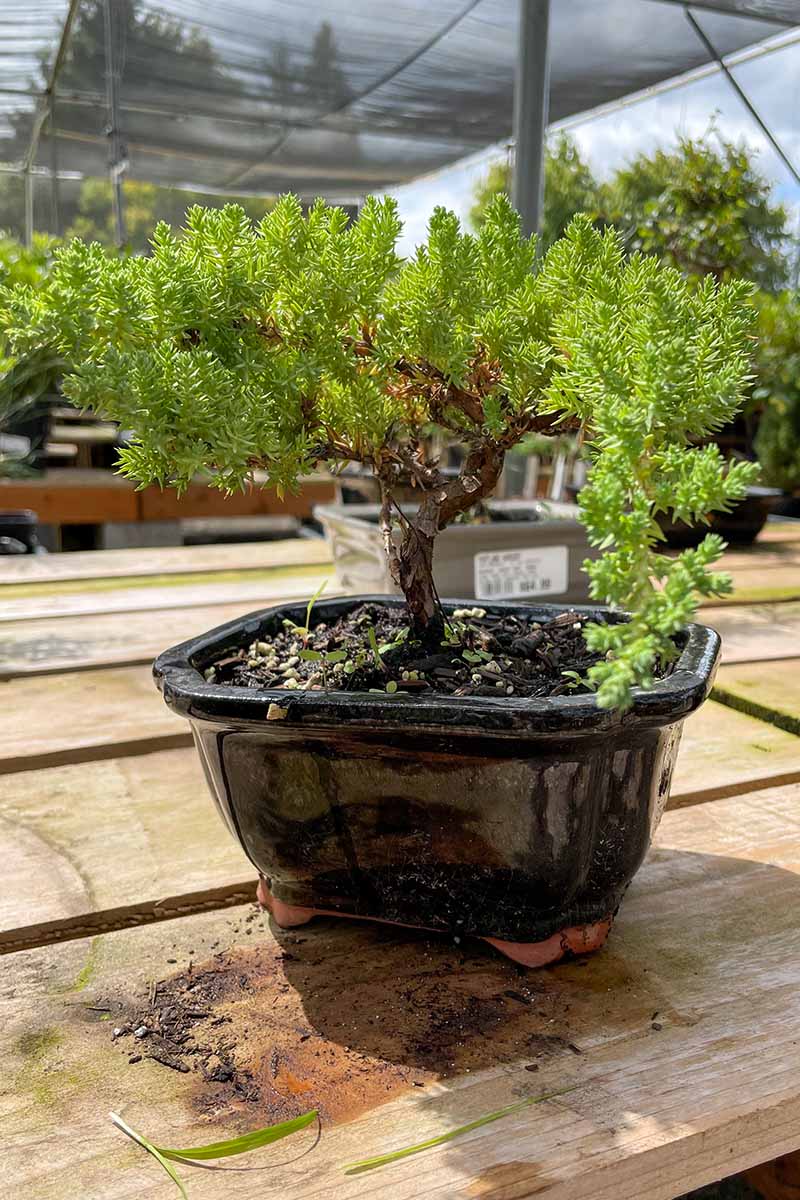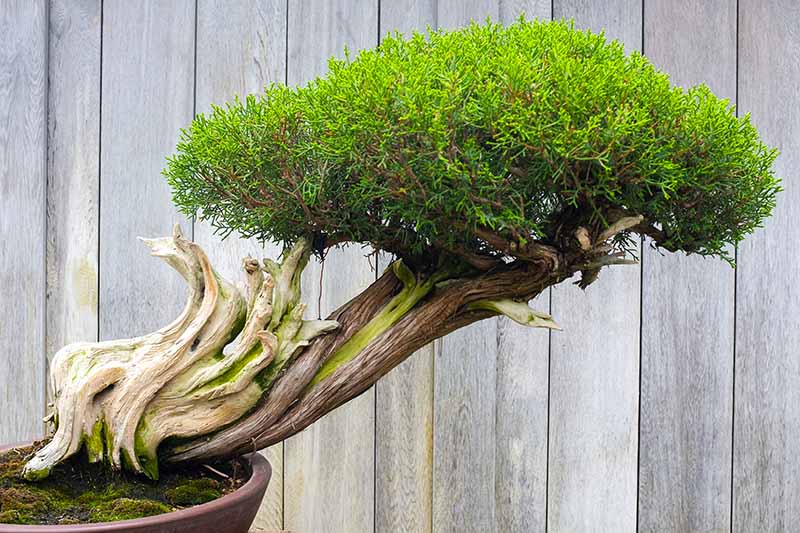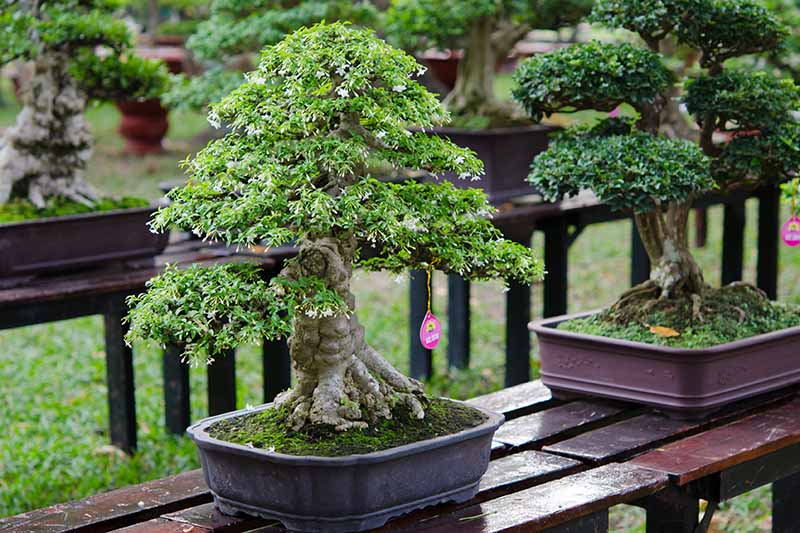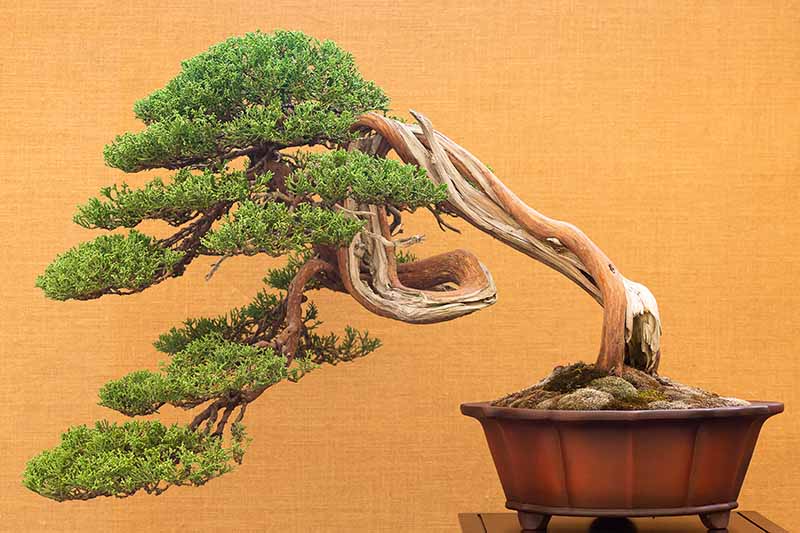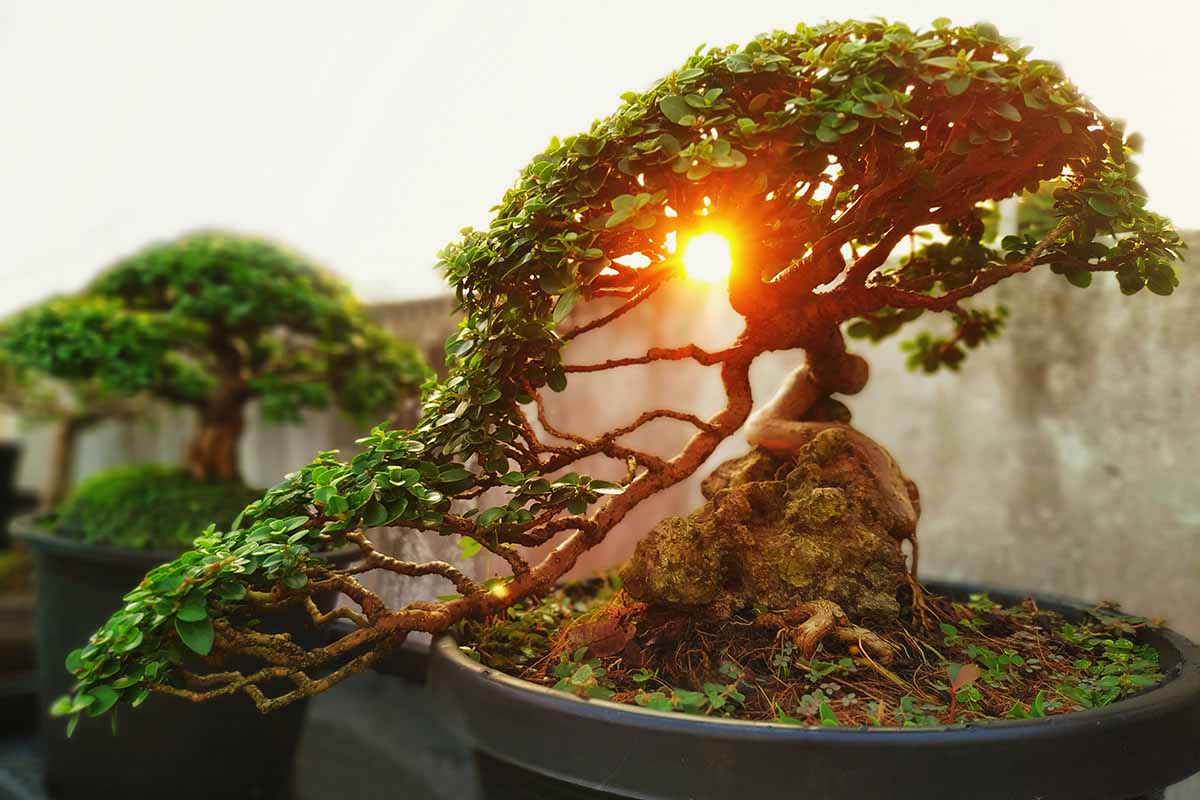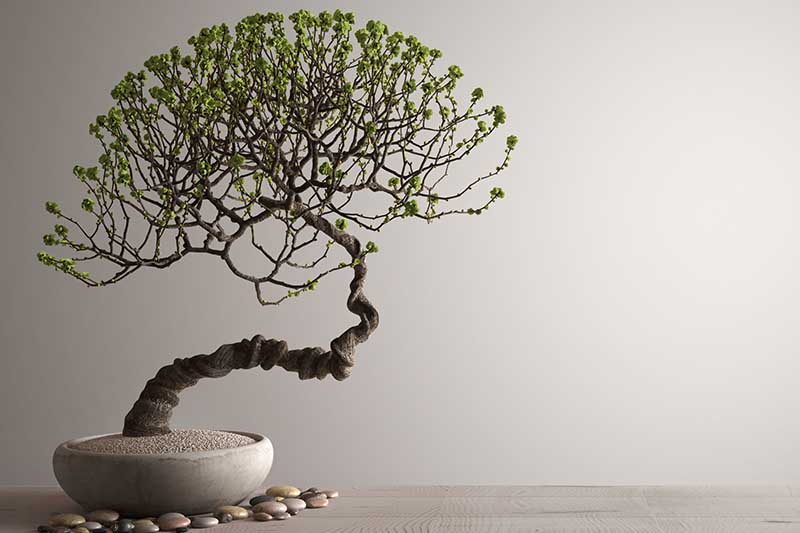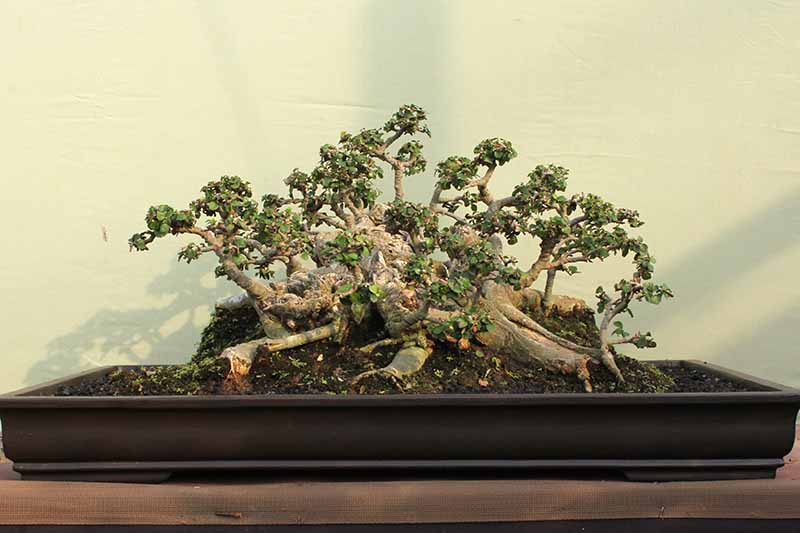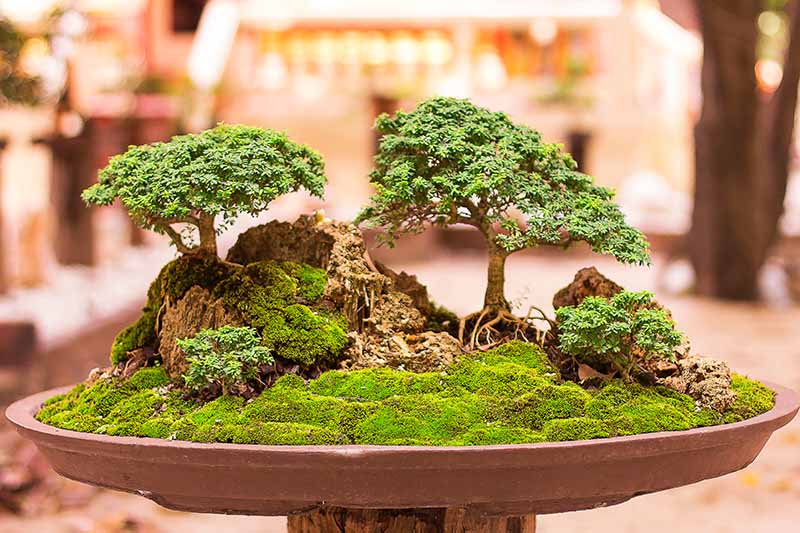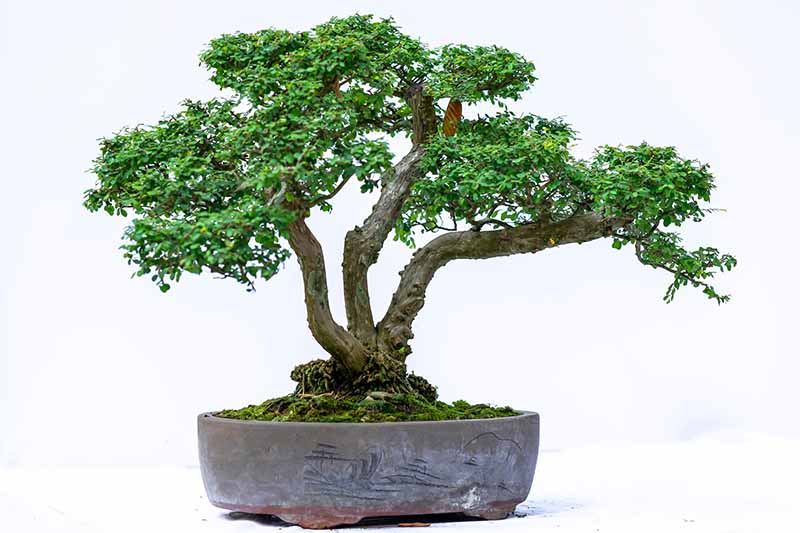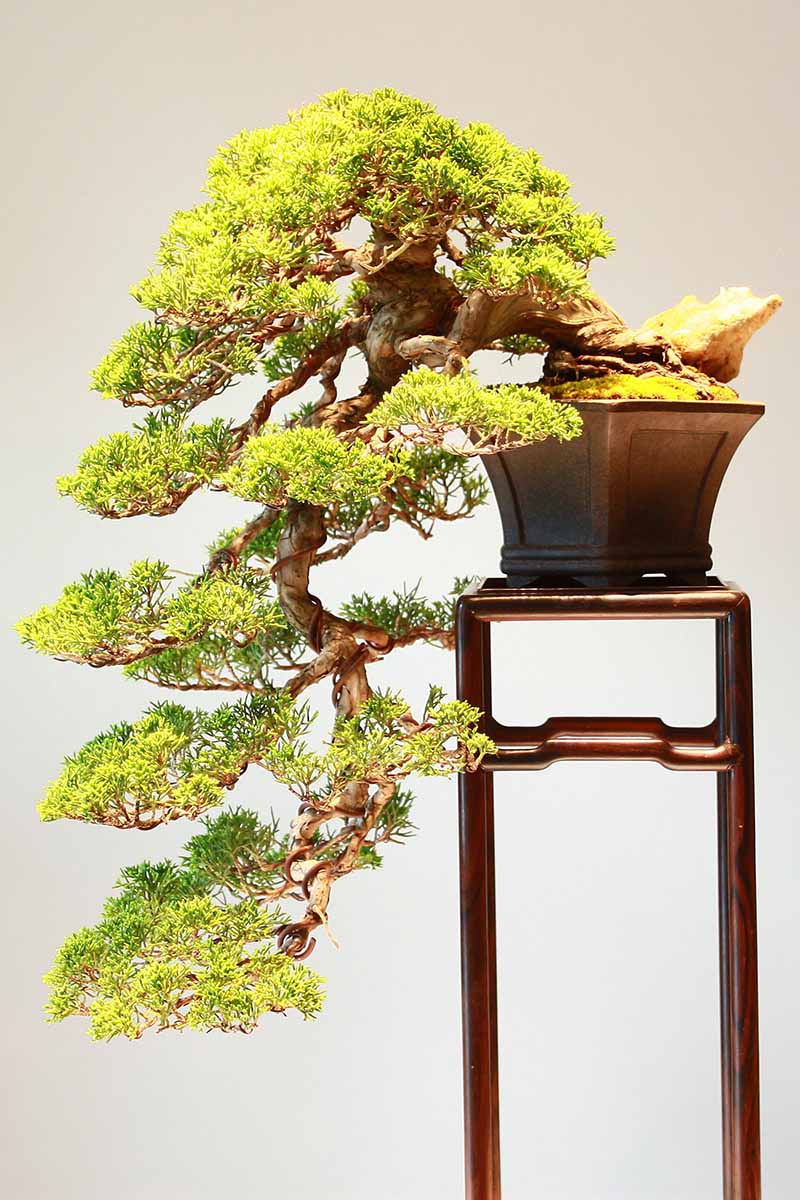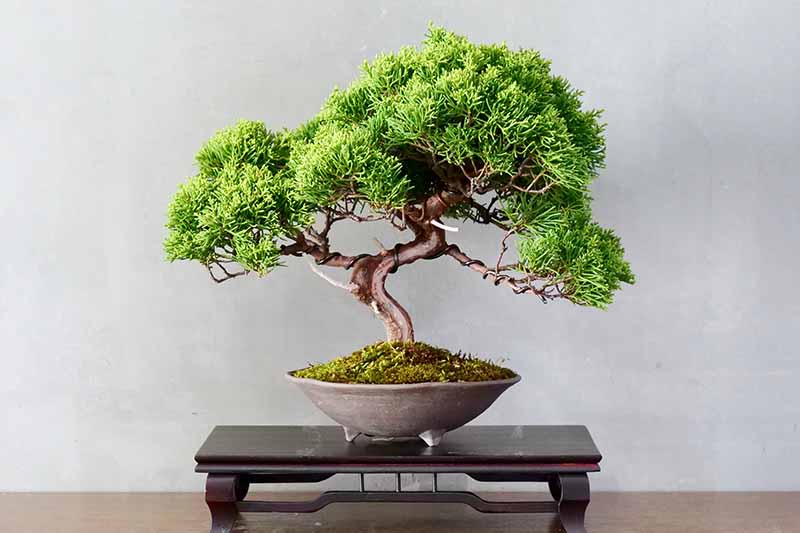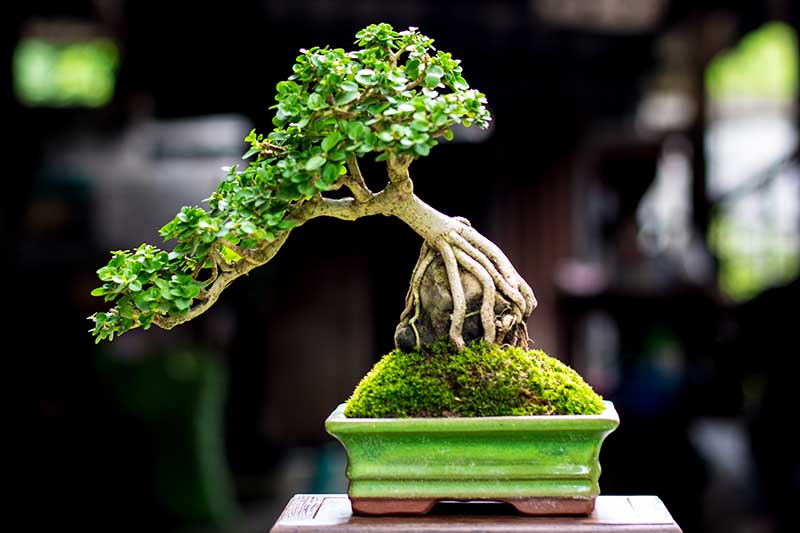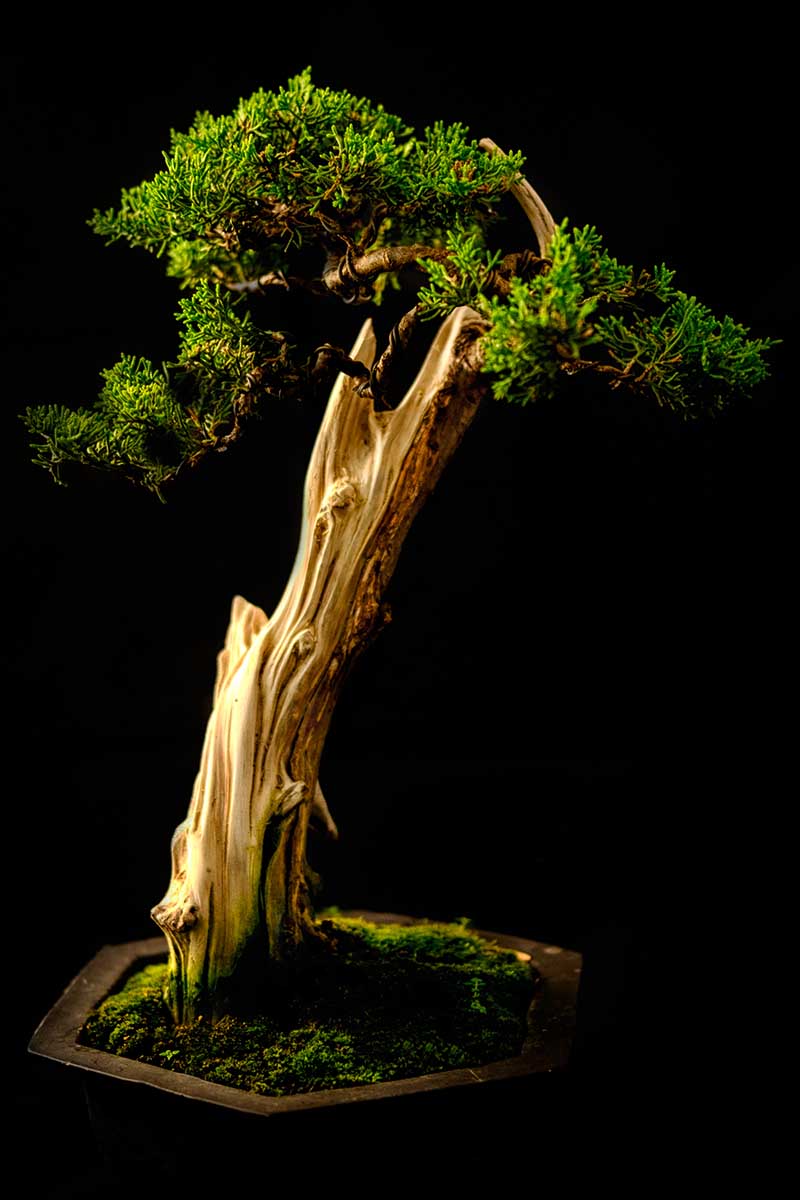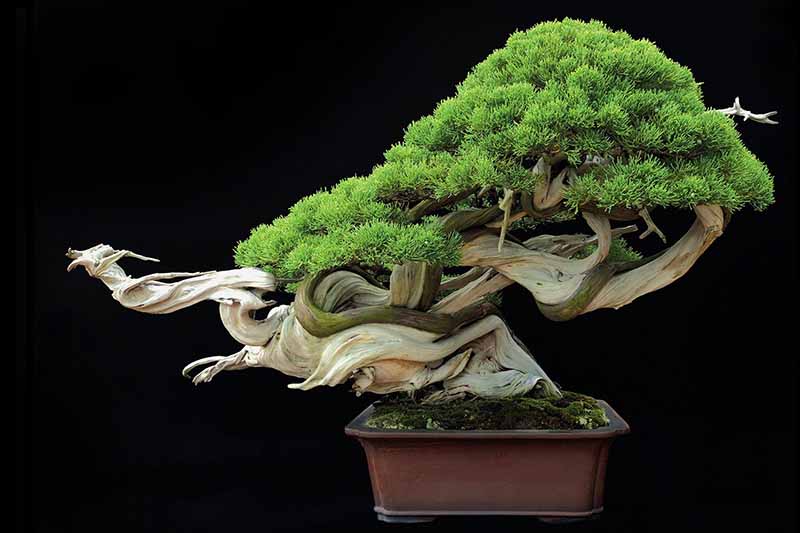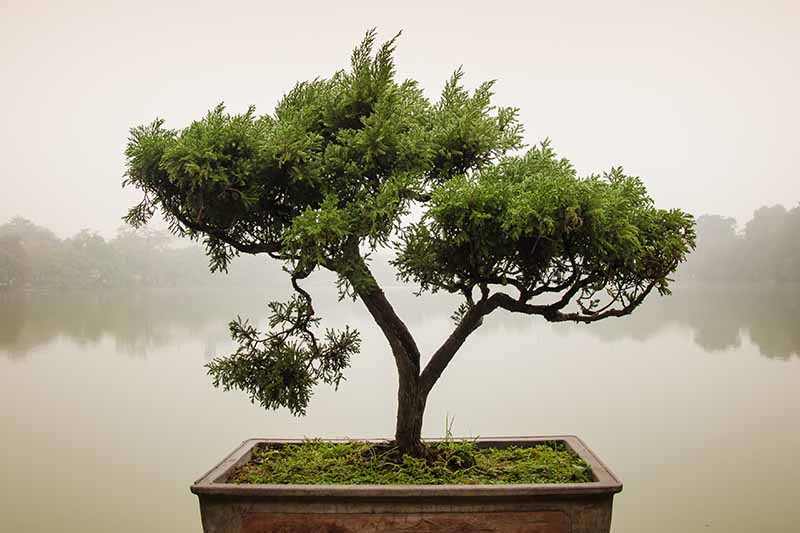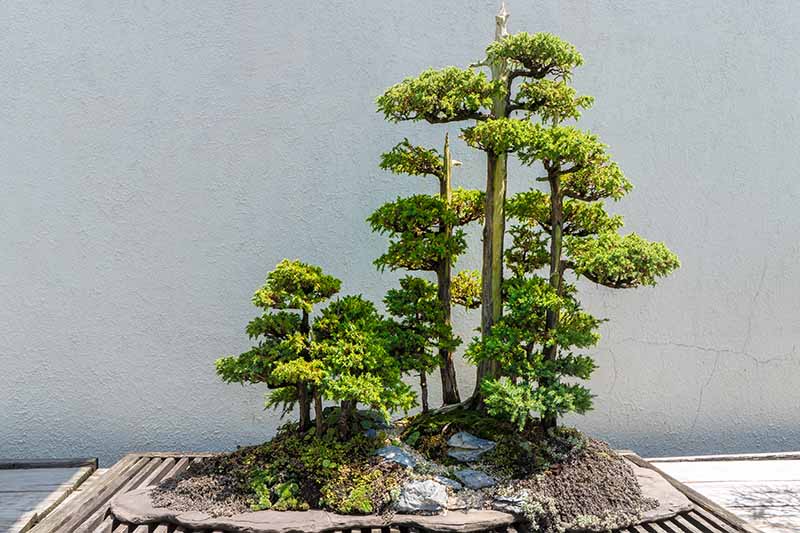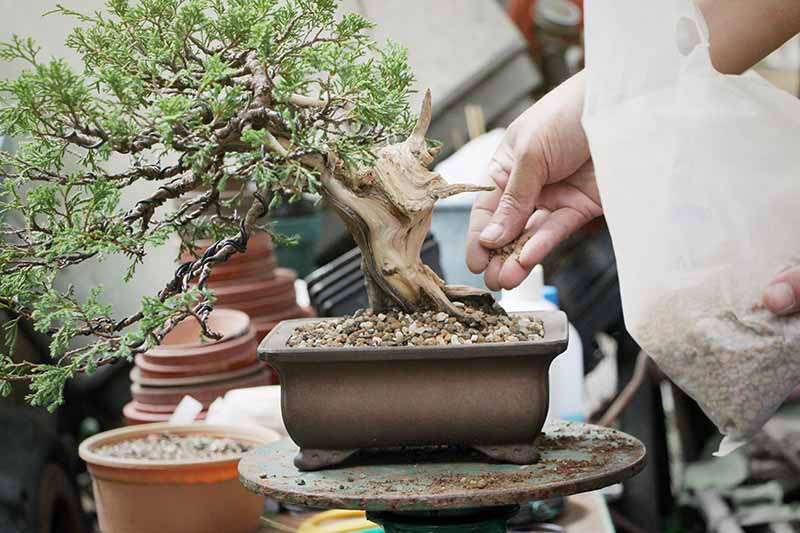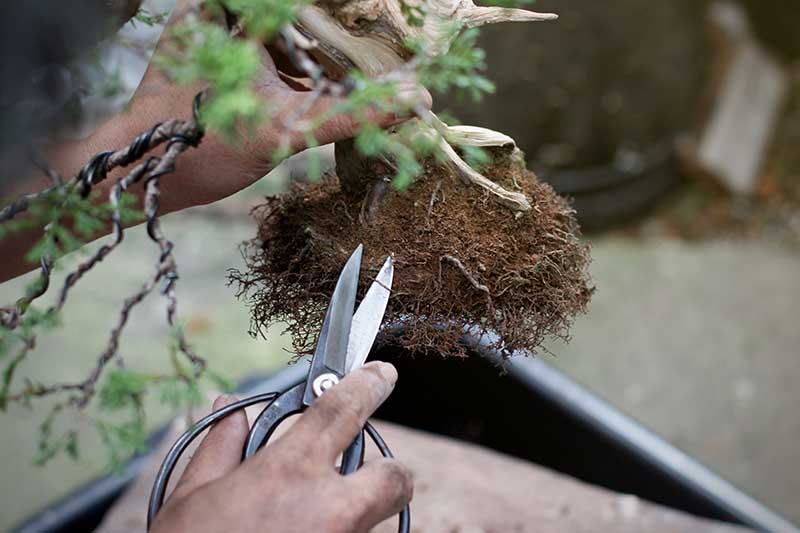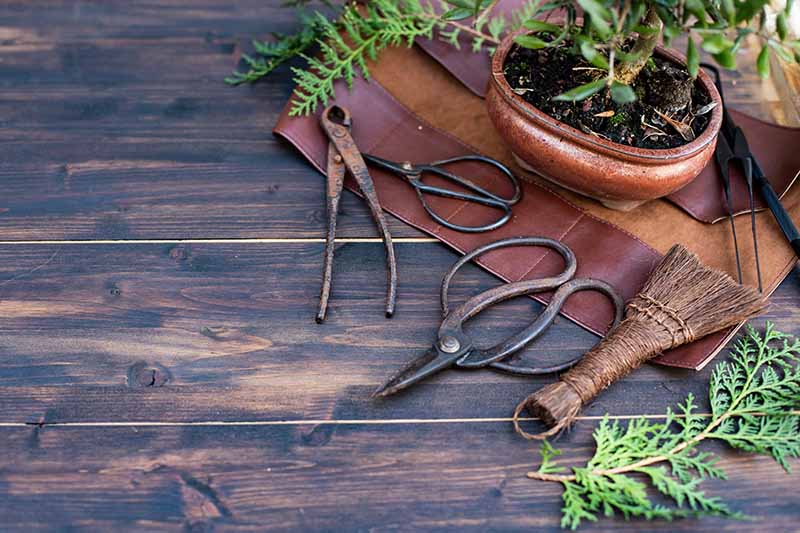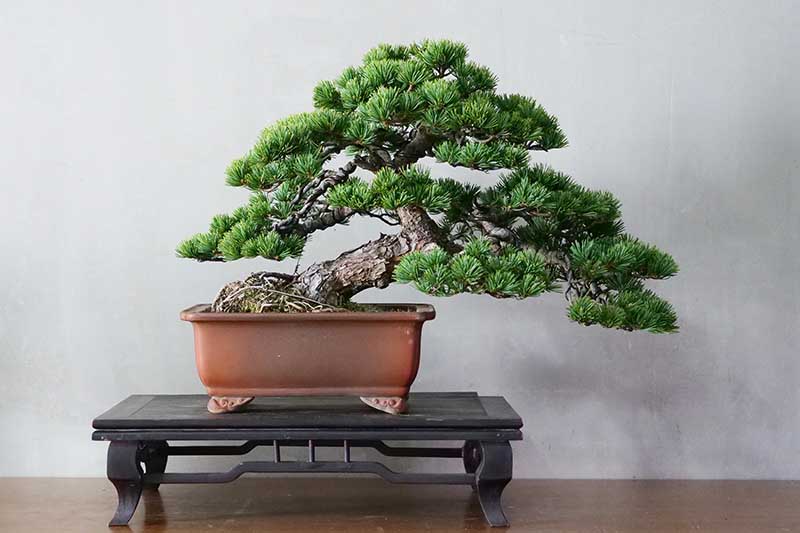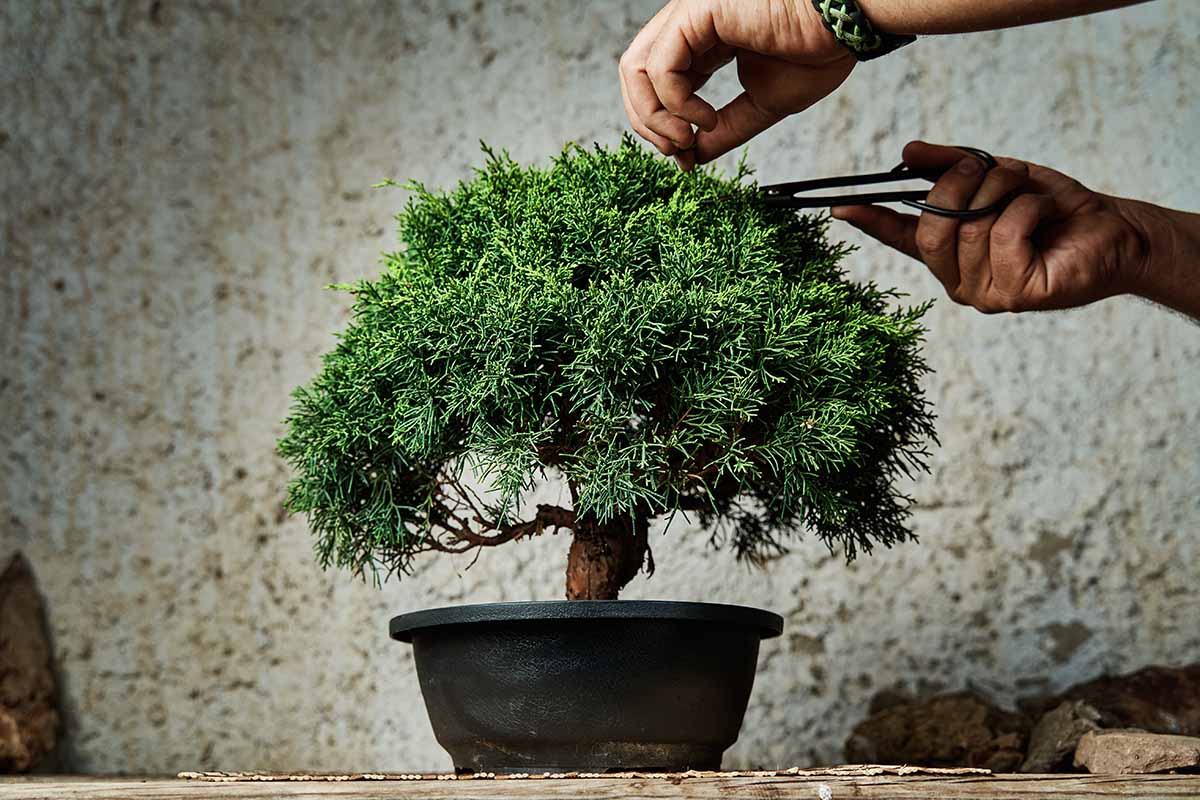It’s not just about trying to grow your favorite tree in miniature. Instead, it’s about capturing the beauty of nature in a living, breathing sculpture. Beginners are often surprised to learn that there’s a lot more to it than feeding and pruning a tree to keep it small. You’ll need to consider every aspect, from selecting the shape and color of the pot to deciding whether or not to wire a branch to create a new shape. We link to vendors to help you find relevant products. If you buy from one of our links, we may earn a commission. You have to ask yourself if your tableau calls for rocks or moss, or whether the root breaking the surface of the soil adds or subtracts from the final picture. And you do this all gradually over the years, with the goal of creating a living snapshot of nature that is never truly complete. Unlike a photo or a painting, a bonsai is never done until the tree has reached the end of its life. That’s part of what makes the process meditative. You can’t rush it, and while you can envision where you want to take your living art, you may never reach your view of perfection. Whether you want to dip your toe into the waters or you’re ready to make a big splash into the deep end, this guide will give you an overview of what you can expect when you enter the world of bonsai. Here’s what we’ll discuss: It can be easy to feel overwhelmed when you start a new hobby, especially one with a history as rich as this one. Don’t worry. We’ll break it all down so that you can feel confident as you start your journey. Let’s go!
What Is Bonsai?
Before we jump in, it helps to have some understanding of what bonsai is. The word bonsai is a loanword from Japanese that is used as a verb to describe the art of raising miniaturized trees through pruning and training. The word is also commonly used as a noun to describe the resulting plants. Bonsai is actually the combination of two words: bon, meaning container or dish, and sai, meaning tree. The words combine to mean something like “tree in a shallow container.” This isn’t the act of cultivating dwarf plants through breeding, but rather, taking plants that are capable of growing to their normal size and keeping them small by constricting their roots and pruning the branches. It’s horticulture meets art. Though the Japanese people made this practice famous worldwide, it actually started in China over 2,000 years ago, where it was called pun-sai or pen-jing. About 1,300 years later, the Japanese started to make it their own after Buddhist monks brought bonsai to Japan from China. Buddhist monks used (and continue to use) the art of bonsai as a method of meditation and as a way to enter a state of flow. While it’s meant to be a feast for the eyes and is treated as a visual art form, much as sculptures or paintings are, it’s also a discipline that requires patience and skill on the part of the practitioner, artist, or hobbyist. Bonsai later made its way to the United States after World War II, when soldiers brought home artifacts from their global travels. Inevitably, that art has been commercialized to the point where you can buy plastic representations today that give you the look without all the work. While I can appreciate wanting to take a shortcut, you can also argue that it defeats the purpose. Bonsai is available to everyone, and it doesn’t require special tools or tons of money to create. You could start your own with a cutting taken from a tree in your yard and grow it in an upcycled yogurt tub if you want. You can even start your plant from seed. That said, you can also purchase pre-started trees and a huge array of pretty containers to put your plant in. There are also a range of tools that you can purchase to make the job easier, though many people prefer to stick to the basics. As with any art, there are various price points for the aficionado, ranging from downright cheap to priceless. Some bonsai trees have been cultivated for centuries, passed down through families, and have never been sold. They are, quite literally, without calculable monetary value. Others have sold for quite a high price to collectors at auction, including a centuries-old Japanese white pine (Pinus parviflora) that reportedly sold for over one million US dollars at the Asia-Pacific Bonsai and Suiseki Convention & Exhibition held in Takamatsu, Kagawa, Japan in 2011. For the rest of us, pre-started young trees can be had for under 20 dollars. And untrained seedlings of plants that work well as bonsai can be had for less than that. It’s easy to become all wrapped up in the art of bonsai, but don’t feel overwhelmed. It can be as simple or as complicated as you want to make it.
How Bonsai Are Made
The goal of this practice is to create a tiny slice of nature in a container. The composition should look like a tree in its native setting… only in miniature. Some appear to be frozen in a strong breeze, while others are totally upright. Some displays feature a single tree, while others feature two, three, four, or more. Most bonsai are grown outdoors, though some can be kept indoors. The chosen plant is placed in a small pot, usually one that is low and wide, though you can use tall and deep pots as well. The tree is then routinely pruned and the roots are trimmed periodically to keep the plant constrained. When a plant is young, it may also be trained to grow into a specific shape using wire, though not every artist does this step. Growers take inspiration from the plant’s natural growth habit. A ginkgo tree usually won’t be trained into a weeping shape, and a weeping cherry won’t be forced to grow upright. Some people may worry that keeping trees contained is cruel. But don’t stress. It doesn’t hurt the tree. People have been pruning the foliage and branches of plants for centuries. Trimming back roots is a time-honored tradition in horticulture to keep a plant small. And growing plants in pots has been going on since pots were invented. Given the care and attention given to bonsai, it wouldn’t be a stretch to say that these plants are better cared for than lots of trees out there. You might also be wondering how long it will take to create a lovely specimen worth displaying. It can happen in just a few years, depending on the species (hello, rosemary!) and the age of the plant you begin with, or it can take decades.
Styles
In general, there are 15 growing styles that plants are trained into. These can be grouped into five categories: formal upright, informal upright, slanting, cascading, and semi-cascading. Don’t feel that you are constrained to fit yours into one of these categories. If your tree is telling you it wants to be something different, follow that inspiration. There is no official standard, and bonsai is an art. You’re only limited by your own vision and imagination. It can help to understand the different styles, however, to give you a base to work from. Let’s take a look.
Bunjingi (Literati)
With the bunjingi style, picture a tree that is surrounded by others in a forest. It has to outcompete other plants by growing tall, and it won’t have lower branches because they’re shaded out by the canopy of the surrounding trees. The trunk is usually curved to appear as though it wound its way upward to find the best light. What’s the name all about? Perhaps more specifically, some might say these mimic the slender, abstract, flowing trees depicted in noteworthy scholarly paintings in the Chinese literati style.
Chokkan (Formal Upright)
This is a common style both in nature and in bonsai. The plant grows straight and tall with a tapering, upright trunk and lots of branches.
Fukinagashi (Windswept)
The fukinagashi tree looks like it has been growing in an extremely windy spot. It will be tilted to the side and all of the branches grow in one direction, though they can originate on any side of the trunk.
Han-Kengai (Semi-Cascading)
Known as semi-cascading, this style mimics trees that grow on a cliffside and are bent over because of strong wind. Unlike the cascading style, semi-cascades grow sideways and down, but never extend below the base of the pot.
Hokidachi (Broom)
Known as broom style, the plant will resemble a broom with a main trunk and lots of fine branches spreading out at the top. The branches are trained to form a ball shape.
Ikadabuki (Raft)
Have you ever seen a tree fall over in the woods, with new trees growing upright out of the trunk? That’s what this style resembles. You’ll see a bunch of trunks growing out of a single trunk growing parallel to the surface of the pot. Eventually, the bottom trunk will often rot away, leaving the new trees in place with elevated roots. The downside to this showy style is that not all species lend themselves to this way of growing. Juniper, quince, spruce, ficus, beech, olive, and pine trees tend to work best.
Ishizuki (Growing-in-Rock)
This style is similar to seki-joju, described below. Only instead of cultivating a tree growing over a rock, it grows within a rock, establishing its roots inside the nooks and crannies. This is a challenging style, and you have to be extremely diligent about watering and fertilizing.
Kabudachi (Multi-Trunk)
This style features groups of more than two trunks coming out of one main trunk and one root system. The trunks are not separate, as they are from the same tree.
Kengai (Cascading)
This is a dramatic cascade style that makes the plant appear as though it is growing on a cliff, and has been crushed regularly by snow or rocks. The trunk should grow up for a bit before arching over and heading down. You need a tall pot for this style, and you will regularly have to encourage the plant to grow downward because it will naturally want to head up towards the light. But done right, it can be graceful and striking. See our guide to pruning a bonsai tree in the cascading style for more information.
Moyogi (Informal Upright)
With the moyogi style, the trunk is shaped like a letter “S,” and tapers at the top. A branch grows out of each curve. This is a common style for evergreens like juniper. The apex should be located in line with the base of the trunk, but the trunk can weave and curve all it wants in the middle.
Seki-Joju (Growing-on-Rock)
Picture a rocky mountain face and the tough trees that make their home by finding nutrition in the cracks and holes between the rocks. That’s what this style seeks to recreate. The tree is grown on a rock with the roots extending over the rock and into the soil below.
Shakan (Slanting)
This style recreates a tree that is buffeted by a constant, steady, light wind. It can also resemble a tree that is growing in the shade of a large building or another tree. The trunk will be slanted as if leaning towards the sun or away from the wind. The lowest branch should grow opposite to the lean of the tree, to provide visual balance. This style differs from fukinagashi in that the tree has a gentle tilt between 60 and 80 degrees relative to the ground, whereas windswept-style trees look like they’re nearly being blown over by heavy winds.
Sharimiki (Driftwood)
Sharimiki doesn’t describe a shape so much as a style that involves removing strips of bark to make it look like the tree has been damaged, or that it’s partially dead or old. These stripped parts will then be bleached, using lime sulfur. The result is a tree that looks extremely weathered and aged.
Sokan (Double)
Trees in this style feature two individual trees of the same type. Both trunks should create one uniform canopy.
Yose-ue (Forest)
This is commonly called the forest style in English, and as you’d expect, it features multiple trees of the same type in one pot. They don’t have to share a root system. The trees are individual, and they don’t create a single canopy. Most artists aim for odd numbers, and the trunks should all be different heights.
Where to Obtain a Bonsai
There are many retailers who sell pre-started bonsai plants that you can find both locally and online. These can range from a year old to hundreds of years old. But if you want to have a hand in your piece of art from start to finish, you’ll want to find your own seeds, seedlings, or cuttings to begin. You can purchase seeds from any trusted purveyor. Depending on the species of plant you intend to grow, you might be able to head to your local nursery, or you may need to do a bit more searching online or at specialty stores. You can take a cutting from any plant that you own or from plants growing in the wild, though you should be sure to check with the landowner or your local laws governing harvesting or foraging parts of plants first. Only choose cuttings from healthy specimens. Beech, boxwood, cedar, fir, hemlock, juniper, yew, birch, elm, ginkgo, maple, willow, wisteria, cotoneaster, and fuchsia are all good candidates. Finally, you can also purchase tiny seedlings at a nursery and train them yourself. Some nurseries even sell seedlings intended for bonsai. Choose healthy plants and avoid anything with yellow leaves, or that looks wilted or unhealthy. Some online retailers, such as Bonsai Boy of New York, feature a product category dedicated to “pre-bonsai,” which are seedlings that are regarded as promising bonsai prospects. These are a great option for someone who wants to start fresh without the influence of an experienced grower, but doesn’t want to start from scratch. Otherwise, you can always purchase a pre-started bonsai and take it from there. This is the most expensive option.
Growing Basics
Once you’ve picked your plant and have envisioned the style you want to go for, here is what you can expect in caring for your new project:
Soil
Healthy bonsai starts with healthy soil. It’s easy to dismiss soil as simply something to hold down the roots, and a medium to store food and water in. But soil is a living thing. It’s made up of solids that include microorganisms and other organic matter, along with air and water. Bonsai roots need to have access to air in order to thrive, so using compacted or heavy soil is a quick way to kill your plant. Soil taken from the garden is typically too compacted for container plants to thrive. Instead, we use a medium that is formulated to allow air to reach the roots while also retaining moisture. Tall pots hold more air and less water, while short pots do the opposite. Round pots hold less water than square ones, and they also have less exposed surface area. That’s something to keep in mind when picking or creating a growing medium. For most beginners, purchasing a pre-made bonsai soil is the easiest way to go. However, these products vary in their quality and composition.
Fertilizer
These miniature plants grow in a minimal amount of soil, which means they don’t have unlimited access to nutrients. They rely on you to provide what they need. Bonsai Boy is an excellent resource if you want to purchase soil that has everything you need and is formulated for different species of plants. For instance, they have a quart-size conifer mix available that is ideal for growing outdoor evergreens. Conifer Soil Mix Or you can pick up a similarly-sized bag of tropical mix, which is intended for indoor plants. If you want to create your own soil, we have a guide to help you with that. In addition to the big three (nitrogen, phosphorus, and potassium, or NPK), they need sulfur, chlorine, boron, zinc, and magnesium. Controlled-release fertilizer (CFR) pellets are your best friend when raising bonsai. It’s easy for nutrients to leach out of the soil when you water, but with a CFR, you can fertilize twice a year and be done with it. Something with slightly more nitrogen is ideal. When you look at a fertilizer package, it will have three numbers, which represent nitrogen (N), phosphorus (P), and potassium (K). You want to choose something with a ratio of about 13-11-11. Because there are so many different species you might want to work with and because scientists haven’t determined exactly what the appropriate amount of other essential elements such as iron, sulfur, calcium, zinc, and magnesium might be from one to the next, fertilizing is an inexact science. Choose something that contains trace amounts of these minerals, but don’t stress over the exact numbers too much. Bonsai Boy’s slow-release fertilizer is formulated to give your plant everything it needs, which makes the process of fertilizing easy. Slow Release Fertilizer Pellets When your plant is young and you are repotting it relatively frequently, you will also need to replace the soil. But as your plant grows older, the soil stays in place longer. It’s a good idea to test the soil every so often to see what specific nutrients it lacks and supplement accordingly.
Watering
Depending on what kind of soil-to-root ratio your bonsai has, and whether the plant is growing indoors or outside, you might need to water frequently – some plants may need watering daily during the heat of summer. Plants growing on rocks need even more water than those growing directly in the soil. You can tell that it’s time to water if the substrate is light in color and the container feels light. You can tap the side of the container and it will sound hollow if moisture levels are low. Touch the soil to see if it feels moist. If you ever notice drooping foliage, this is a good indication that you waited too long to water. At the same time, you don’t want to overwater. This will drown the roots. Don’t add more water if the soil feels moist. You’ll also want to decrease watering for outdoor plants during the winter when they are dormant.
Pruning
Much of the art of bonsai involves pruning. But we’re not just talking about the stems and leaves. You also need to prune the roots. At least every few years, you need to lift the plant from its pot and prune to remove any dead, diseased, or broken roots, and to encourage the formation of a compact mass. Above ground, you’ll need to prune the branches, stems, and leaves to create a pleasing shape, to encourage bushier growth, and to remove any unsightly or unhealthy growth. Our guide to pruning has more information.
Supplies
Managing Pests and Disease
Because there is such a large range of plants available that can be grown as bonsai, there is an equally massive range of different diseases that can impact them. Many people like to invest in pruners designed especially for bonsai because they’re so small. Concave pruners work best because they are less likely to leave behind obvious scarring. These can be a little hard to find locally, so you might want to look online at a specialty retailer such as Bonsai Boy if you aren’t lucky enough to have a specialty shop in the area. Wazakura Hand Forged Branch Cutter You might also want to purchase a pair of shears for the finer work, though regular kitchen shears work too. Satsuki Shears You can grab yourself a pair at Bonsai Boy if you’d like to add some to your toolkit. You can also buy shapers, which can be used to bend branches more dramatically than can be accomplished with wire alone. Bonsai Boy carries these handy tools, as well. You might also want to use grow lights, depending on the species you are raising, and a watering can that lets you aim the water more easily into the tiny container. Some people like to add miniature figurines, but this is discouraged in traditional Japanese bonsai practice. If you’re looking for a book that can give you more information on mastering these elements, “Modern Bonsai Practice” by Larry Morton is an excellent resource. It busts many of the myths and common misconceptions about raising bonsai using scientific research and experience from dozens of experts. Modern Bonsai Practice It also features dozens of portraits of exceptional bonsai so you can find some extra inspiration. The American Bonsai Society also serves as an excellent supplementary resource for beginners as well as more advanced enthusiasts. The best way to figure out what might be impacting your plant is to research the particular fungi, bacteria, and insects that may attack your selected species of plant. In general, always be sure to remove any leaves that have spots or blemishes, and keep an eye out for any insects or eggs.
Basic Bonsai Aesthetics
We won’t get too deep into the basic artistic elements of bonsai here since that’s an entire world unto itself, but the elements that make up the visual art of bonsai are the same as many forms of visual art, such as photography and painting. You want to strive for balance. That doesn’t necessarily mean your tree has to be symmetrical. Empty space or asymmetry can have a striking visual impact. You should also aim to create lines that move the eye, whether that’s down the cascade of a weeping style or up the line of an upright style. Proportion should always be considered as well, but you have a wide latitude to play with this element. Finally, there are a few “rules” that strict practitioners typically follow, but you should feel free to bend the rules if it makes you happy. Just be aware that if you ever plan to exhibit your tree, breaking any of these rules will likely knock you out of the competition. These include:
Never growing any other vegetation in the pot besides the bonsai and moss.Not including any decorative elements besides wood, rocks, soil, and moss.The trunk should taper from the base to the top, and the branches should be smaller the closer they are to the top.The foliage should be in proportion to the trunk and branches.Never growing more than one species in a single container.
Remember that bonsai serves as an artistic outlet as well as a meditative hobby. All types of gardening are excellent for stress relief, and every gardener has their own unique aesthetic sensibilities. That’s because practising the art also involves having the humility to understand and recognize that you are always learning. Just as your piece of art will never be complete, nor will you ever complete your journey toward mastering the art. And that’s a good thing! In fact, the Japanese language captures this idea perfectly with the word shokunin, which describes a craftsman on the quest to master their chosen art. The most important word here is “quest,” which indicates that it is a process, not an end goal or something to achieve and then move on from. Once you start your first project, we’d love it if you’d come back and share your progress, or ask any questions that you have. Leave them in the comments below so we can all share the details of our own quests for mastery. Then, if you feel like you’re ready to tackle the next level of your bonsai education, we have a few other guides that I hope you’ll find helpful, starting with these:
How to Get Started with Your First Bonsai TreeHow to Grow and Train Dracaena Plants as BonsaiGrowing Fruit Trees as Bonsai

